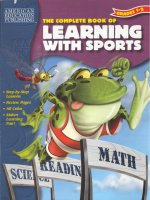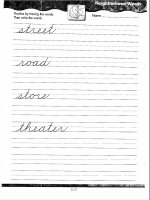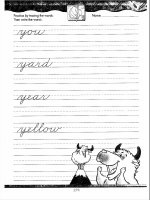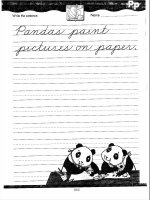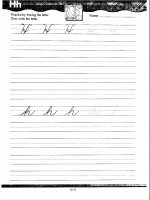The complete book of home inspection
Bạn đang xem bản rút gọn của tài liệu. Xem và tải ngay bản đầy đủ của tài liệu tại đây (9 MB, 382 trang )
The
Complete Book of
Home Inspection
This page intentionally left blank
The
Complete Book of
Home Inspection
Fourth Edition
Norman Becker, P.E.
New York Chicago San Francisco Lisbon London Madrid
Mexico City Milan New Dehli San Juan Seoul
Singapore Sydney Toronto
Copyright © 2011, 2002, 1993, 1980 by The McGraw-Hill Companies, Inc. All rights reserved. Except as permitted under the United
States Copyright Act of 1976, no part of this publication may be reproduced or distributed in any form or by any means, or stored in
a database or retrieval system, without the prior written permission of the publisher.
ISBN: 978-0-07-170278-2
MHID: 0-07-170278-4
The material in this eBook also appears in the print version of this title: ISBN: 978-0-07-170277-5,
MHID: 0-07-170277-6.
All trademarks are trademarks of their respective owners. Rather than put a trademark symbol after every occurrence of a trademarked name, we use names in an editorial fashion only, and to the benefit of the trademark owner, with no intention of infringement
of the trademark. Where such designations appear in this book, they have been printed with initial caps.
McGraw-Hill eBooks are available at special quantity discounts to use as premiums and sales promotions, or for use in corporate
training programs. To contact a representative please e-mail us at
Information contained in this work has been obtained by The McGraw-Hill Companies, Inc. (“McGraw-Hill”) from sources believed
to be reliable. However, neither McGraw-Hill nor its authors guarantee the accuracy or completeness of any information published
herein, and neither McGraw-Hill nor its authors shall be responsible for any errors, omissions, or damages arising out of use of this
information. This work is published with the understanding that McGraw-Hill and its authors are supplying information but are
not attempting to render engineering or other professional services. If such services are required, the assistance of an appropriate
professional should be sought.
TERMS OF USE
This is a copyrighted work and The McGraw-Hill Companies, Inc. (“McGrawHill”) and its licensors reserve all rights in and to the
work. Use of this work is subject to these terms. Except as permitted under the Copyright Act of 1976 and the right to store and retrieve one copy of the work, you may not decompile, disassemble, reverse engineer, reproduce, modify, create derivative works based
upon, transmit, distribute, disseminate, sell, publish or sublicense the work or any part of it without McGraw-Hill’s prior consent.
You may use the work for your own noncommercial and personal use; any other use of the work is strictly prohibited. Your right to
use the work may be terminated if you fail to comply with these terms.
THE WORK IS PROVIDED “AS IS.” McGRAW-HILL AND ITS LICENSORS MAKE NO GUARANTEES OR WARRANTIES AS TO THE ACCURACY, ADEQUACY OR COMPLETENESS OF OR RESULTS TO BE OBTAINED FROM USING
THE WORK, INCLUDING ANY INFORMATION THAT CAN BE ACCESSED THROUGH THE WORK VIA HYPERLINK OR
OTHERWISE, AND EXPRESSLY DISCLAIM ANY WARRANTY, EXPRESS OR IMPLIED, INCLUDING BUT NOT LIMITED
TO IMPLIED WARRANTIES OF MERCHANTABILITY OR FITNESS FOR A PARTICULAR PURPOSE. McGraw-Hill and its
licensors do not warrant or guarantee that the functions contained in the work will meet your requirements or that its operation will
be uninterrupted or error free. Neither McGraw-Hill nor its licensors shall be liable to you or anyone else for any inaccuracy, error
or omission, regardless of cause, in the work or for any damages resulting therefrom. McGraw-Hill has no responsibility for the
content of any information accessed through the work. Under no circumstances shall McGraw-Hill and/or its licensors be liable for
any indirect, incidental, special, punitive, consequential or similar damages that result from the use of or inability to use the work,
even if any of them has been advised of the possibility of such damages. This limitation of liability shall apply to any claim or cause
whatsoever whether such claim or cause arises in contract, tort or otherwise.
For Renée, Jeffrey, Piper, Ana Maria, Sharon, Mia, and Eli
This page intentionally left blank
About the Author
Norman Becker, P.E. (Hamburg, New Jersey), has more than 35 years’ experience
in home inspection. He has inspected homes of all ages, from newly constructed
to prerevolutionary, from vacation homes to stately mansions. He is one of the
founders of the American Society of Home Inspectors (ASHI) and has been
qualified in court as an expert witness on the subject of home inspection. He
also wrote the widely read “Homeowners Clinic” column for Popular Mechanics
magazine for 24 years and is the author of the Popular Mechanics book 500 Simple
Home Repair Solutions. Mr. Becker is a licensed professional engineer in New York,
New Jersey, and Florida.
This page intentionally left blank
Contents
Acknowledgments
xvii
Introduction
xix
1 Tools and procedure
Tools needed
1
Inspection procedure
2
Exterior inspection
2
Interior inspection
3
Electromechanical systems
Final inspection
5
1
4
EXTERIOR INSPECTION
2 Roofs
6
Pitched roofs
6
Shingles
8
Flat roofs
16
Built-up roofs (BURs)
17
Single-ply membrane
19
Roll roofing
19
Metal roofing
19
Checkpoint summary
20
Contents ix
3 Roof-mounted structures and projections
22
Chimneys
22
Vent stacks
26
Roof vents
27
Roof hatch
28
Skylights
28
TV antennas
28
Lightning protection
29
Gutters and downspouts
29
Built-in gutters
30
Exterior-mounted gutters
30
Downspouts
32
Checkpoint summary
34
4 Paved areas around the structure
Sidewalks
36
Street-level/driveway-level steps
Front and side paths
37
Entry steps
37
Patio
38
Driveway
39
Checkpoint summary
41
36
5 Walls, windows, and doors
Exterior walls
43
Exterior siding
44
Masonry wall
51
Trim
52
Windows
53
Inspection
55
Exterior doors
56
Storm windows, screens, and storm doors
Storm windows
58
Screens
58
Storm doors
59
Inspection
59
Caulking
59
Checkpoint summary
60
6 Lot and landscaping
Drainage
62
Groundwater, water table
Inspection
67
Retaining walls
70
Inspection
71
x Contents
36
42
58
62
65
Landscaping
74
Lawn
74
Shrubs
75
Trees
76
Decks
76
Free-standing decks
79
Composite decks
79
Fences
80
Checkpoint summary
81
7 Garage
84
Attached garage
84
Fire and health hazards
84
Plumbing check
86
Flood potential
88
Doors
88
General considerations
89
Detached garage
90
Exterior
90
Interior
91
Heat and electricity
92
Checkpoint summary
93
8 Wood-destroying insects and rot
Termites
95
Subterranean termites
98
Dry-wood termites
105
Formosan termites
106
Other wood-destroying insects
Carpenter ants
106
Powder-post beetles
108
Rot
109
Inspection
110
Checkpoint summary
112
95
106
INTERIOR INSPECTION
9 Attic
114
Insulation
115
Violations
116
Leakage
117
Fire hazards
117
Ventilation
118
Attic fan
120
Whole house fans
120
Structural
121
Checkpoint summary
123
Contents xi
10 Interior rooms
124
Walls and ceilings
125
Mold-resistant drywall
126
Chinese drywall
128
Floors
128
Heat
131
Windows
131
Electrical outlets
132
Fireplace
134
Gas-fired fireplace
136
Bedrooms
136
Bathrooms
137
Water pressure and flow
138
Kitchen
141
Hallway and staircase
142
Checkpoint summary
143
11 Basement and crawl space
147
Foundation
147
Settlement
148
Inspection
149
Dampness
154
Water seepage—causes and control
155
High groundwater level
155
Hydrostatic pressure—walls
156
Inspection
158
Furnace room
163
Ventilation
165
Crawl space
165
Conditioned crawl space
167
Checkpoint summary
168
ELECTROMECHANICALS
12 Electrical system
Inlet electrical service
170
Electrical capacity
171
Fuses and circuit breakers
174
Inlet service panel box
175
Panel-box interior
176
Aluminum wiring
176
Grounding
177
Improper ground connections
177
Interior electrical inspection
178
Electrical outlets
178
xii Contents
170
Knob-and-tube wiring
180
Low-voltage switching systems
Violations
181
Checkpoint summary
181
180
13 Plumbing
183
Water supply and distribution
184
Fixtures
185
Drainage system
185
Waste-disposal system
186
Cesspool
187
Septic system
187
Exterior inspection
191
Vent stack
191
Fresh-air vent
192
Lawn sprinkler systems
192
Septic system
193
Interior inspection
193
Fixtures
193
Cross-connection
193
Water pressure, flow
194
Plumbing wall hatch
194
Pipes
195
Basement inspection
197
Water-supply pipes
197
Distribution piping
198
Drainage pipes
199
Well-pumping systems
202
Wells
202
Well pumps
203
Accessory equipment
205
General considerations
206
Checkpoint summary
207
14 Heating systems I
Central heating systems
210
Heating outlets: registers and radiators
Thermostat and master shutoff
211
Warm-air systems
212
Advantages
213
Disadvantages
213
Gravity warm air
213
Forced warm air
215
Heat pump
218
Geothermal heating/cooling
218
209
211
Contents xiii
Hot-water systems
219
Gravity hot water
219
Forced hot water
221
Steam heating systems
227
Distribution piping
228
Controls
229
Domestic water heater
231
Advantages and disadvantages
Hybrid heating systems
231
Steam–hot water
231
Hydro-air 231
231
15 Heating systems II
233
Oil-fired systems
233
Gas-fired systems
235
Electrical systems
236
Area heaters
236
Gas-fired units
237
Electrical units
237
Heating system inspection procedure
Warm-air systems
239
Hot-water systems
241
Steam systems
242
Oil burners
243
Gas burners
244
Checkpoint summary
244
237
16 Domestic water heaters
247
Tank water heaters
248
Reversed connection
248
Relief valve
249
Rumbling noise
251
Exhaust stack
252
Operational inspection
252
Water heater replacement
254
Water heater capacity and recovery
255
Tankless (coil) water heaters
256
Inspection procedure
258
Tankless (wall-mounted) water heaters
259
Indirect-fired storage water heaters
260
Checkpoint summary
261
17 Air-conditioning
Air-conditioning capacity
Air-conditioning systems
Integral system
264
xiv Contents
262
263
264
Split system
264
Heat pump
272
Evaporative cooler
Checkpoint summary
273
273
18 Swimming pools
275
Concrete pools
275
Vinyl-lined pools
276
Preformed fiberglass pools
277
Pool equipment
278
Pool accessories
280
Inspection procedure
280
Checkpoint summary
282
OTHER ISSUES
19 Energy considerations
283
Energy audit
283
Insulation
284
Attic ventilation
287
Storm windows
288
Caulking and weatherstripping
289
Fireplaces and wood-burning stoves
289
Heating and air-conditioning systems
290
20 Environmental concerns
Radon
292
Asbestos
295
Drinking water
297
Lead
298
Formaldehyde
300
Leaky oil tanks
300
Electromagnetic fields
Mold
302
292
301
21 Green home technology
Roof
307
Roof-mounted structures
307
Paved areas around the structure
307
Exterior walls—siding (cladding)
308
Deck
308
Windows
308
Structural framing
309
Heating, ventilation, and air-conditioning (HVAC)
Water heating
310
304
309
Contents xv
22 Conclusion
Professional home inspection
312
Home inspection limitations
312
Real estate warranty program
313
Private home inspection warranty programs
Manufacturers’ warranties
314
Contract
314
312
314
Appendix
316
Home inspector requirements
316
Quiz based on The Complete Book of Home Inspection
319
Quiz answers
334
ASHI Standards of Practice
335
ASHI Code of Ethics
343
ASHI membership categories and requirements
344
Glossary
345
Inspection worksheets
348
Index
355
xvi Contents
Acknowledgments
I would like to thank Victor J. Faggella of
Centurion Home Inspections in Mahopac,
New York, for his suggestions and overall
help and support in bringing this fourth edition to a timely finish. Thanks to David Stewart
of Expert Home Inspections in Hamburg,
New Jersey, for his helpful comments on New
Jersey’s licensing law. Also, many thanks to
Douglas Hansen in San Rafael, California,
for his help with the quiz at the end of this
book, which is a test to see if you were asleep
when you were reading the book.
Acknowledgments xvii
This page intentionally left blank
Introduction
Over the years various new products and
systems become available for house
construction that are of interest to home buyers and owners as well as to home inspectors
who have to examine and evaluate them.
With each new edition of this book, I have
tried to include those products and systems
as well as items that may have inadvertently
been omitted in the previous edition.
In this fourth edition, most of the chapters
have been expanded to include additional items
that should be checked during an inspection.
Some of these topics are metal shingles,
synthetic slate, fiber-cement siding, composite
decking, free-standing decks, Superior Walls,
conditioned space, Chinese wallboard,
mold-resistant drywall, engineered lumber,
laminate flooring, engineered hardwood
flooring, bamboo flooring, air admittance
valves, loop vents for island kitchens, hydroair, geothermal heating and cooling, electronic
low-water cutoffs, alternative septic systems
(mound systems and alternating drainfields
systems), PEX piping, recirculating hot water
systems, tankless water heaters, and arc fault
circuit interrupters. In addition, there is a new
chapter titled “Green Home Technology” and
an appendix that includes home inspector
requirements.
By following the procedures outlined in
this book, a home buyer will be able to look
beyond the cosmetic and have a good idea as
to the true condition of the house. The book
is also helpful to an owner, who can use it to
determine problems or potential problems in
the house. There could be problems caused
by deterioration as a result of aging or there
could be safety or fire hazards. Very often
the problems could be quite minor and could
be corrected at little or no cost; however, if
left unattended they could be quite costly to
correct.
The section on home inspector requirements was included because I felt it was
Introduction xix
important to inform the public about the
demanding requirements and the training
needed to become a professional home
inspector. It will also be of interest to the
many engineers, architects, and contractors
who would like to work as home inspectors.
xx Introduction
The book should also be quite helpful to
a buyer who wants to hire the services of a
home inspector to check the condition of a
prospective home.
Norman Becker, P.E.
The
Complete Book of
Home Inspection
This page intentionally left blank
1
Tools and procedure
Tools needed 1
Inspection procedure 2
Exterior inspection 2
Interior inspection 3
Electromechanical systems
Final inspection 5
4
The inspection procedure outlined in this
book is similar to the one that I use when
inspecting residential structures. Because the
various components of homes are basically
the same, this procedure is valid regardless
of the geographic location of the structure.
It has been used on homes of all ages, from
newly constructed to pre-Revolutionary, from
vacation homes to stately mansions.
Tools needed
To inspect the house properly, you will need
the following tools: a flashlight, to see in dark
places (and you’ll be surprised what you
might find); a magnet, to determine whether
plumbing pipes are iron; a marble, to note
whether the floors are relatively level; an ice
pick or screwdriver, to aid in looking for wood
rot and termite infestation; a 6-foot stepladder,
for those houses that do not provide direct
access (built-in or pull-down steps) to the attic;
an electrical tester, for checking the electrical
ground connection and the electrical polarity,
particularly in the kitchen and bathroom
outlet receptacles; binoculars, to get a closer
look at the roof and roof-mounted structures;
a thermometer to check the temperature of
the domestic hot water; and a compass, to
determine the building’s exposure. Knowledge
of the exposure is helpful in evaluating the
condition of various structural elements and
components.
Since the first edition was published, a
number of electronic tools have come on the
market that are being used by professional
home inspectors. The one tool that I would
recommend for homeowners and home
buyers is a battery-operated moisture meter
that checks for water leaks without damaging
the surface being tested. One manufacturer
of moisture meters is Delmhorst Instrument
Co. They can be reached at (800) 222–0638
for information on purchasing a meter. You
may have read about infrared cameras that
can be used for thermal imaging of a house.
The cameras are used for detecting heat loss,
insulation deficiencies, and specific areas of air
infiltration, and for locating moisture problems.
Handling of these cameras, which are quite
expensive, requires special training so that the
images can be accurately interpreted. Infrared
Tools needed 1
cameras are not normally used during a home
inspection. Most professional home inspectors
do not have the camera, and those who do
charge an additional fee for the service.
When performing the inspection, you
should wear old clothes. Areas such as
unfinished attics, basements, and crawl spaces
are often quite dusty. The last items you need
for inspection are a pencil and inspection
worksheets. The worksheets are provided in
the back of this book and should be completed
as you perform the inspection. Later, you
can use these worksheets to evaluate the true
condition of the house and base your decision
on facts rather than emotion.
Inspection procedure
A house, no matter how large or imposing,
can be easily inspected if it is divided into its
component parts, such as the exterior, interior,
and electromechanical systems. The exterior
and interior portions can be further subdivided.
By approaching the inspection in a systematic
order and using the worksheets provided as a
guide, all the items of any consequence will be
checked.
When driving up to the house, take a
moment to notice the overall topography or
shape of the land. Often, the topography in
the immediate vicinity of the house is level;
however, the overall topography might be
inclined. Consequently, the possibility exists of
subsurface water movement in the direction of
the house. When you see inclined topography
in the general area of the house, you should be
alerted to the possibility of some water seepage
into the lower level of the structure.
The exterior of the building should be
inspected before the interior. This order is
important because it provides you with an
overall view of the structure that in turn can
reveal the cause for some interior problems.
Specifically, water seepage into a lower level can
2 Tools and procedure
be the result of faulty gutters or downspouts,
or improper grading (the ground immediately
adjacent to the house slopes toward the house
rather than away). A faulty roof can manifest
itself in water stains one or two levels below
the roof. Cracked and open exterior joints can
allow the entry of water, which you will note
as cosmetic damage to interior portions of the
structure.
Exterior inspection
Before you start the exterior inspection, stand
in front of the house and take a compass
reading. The exposure for all four sides
of the building should be marked on the
worksheet (i.e., Front exposure—southerly;
Right exposure—easterly, etc.). The exterior
inspection is performed while walking around
the house twice. The first time, you should look
at the roof, gutters, chimney, vent stack, and
anything else that is roof-mounted. The details
of what to look for and how to inspect the
various components of the house are discussed
in the chapters that follow. During this first
pass around the house, use binoculars so that
you can get a closer view of the items on the
upper portion of the structure. The binoculars
should not have a magnification greater than
8X (eight times actual size). A more powerful
pair of binoculars will tend to exaggerate hand
movement, making it difficult to see details.
The slightest hand movement will cause a
blurred image. This problem, however, can
be eliminated if you have a (more expensive)
pair of 10X power binoculars with image
stabilization.
After the first pass, the condition of
those items inspected should be noted on the
worksheet. If your first pass around the house
is in the winter just after a snow, be careful
where you walk. There may be a swimming
pool behind the house that is covered over
with snow. If you are concentrating on the




